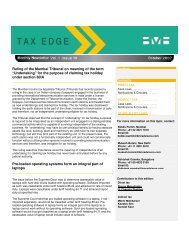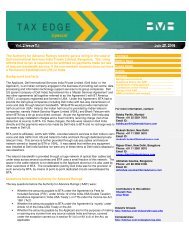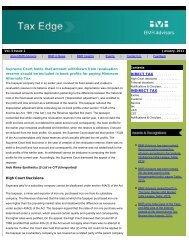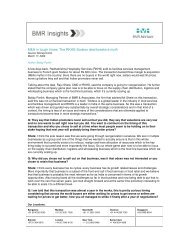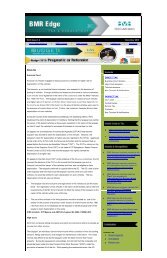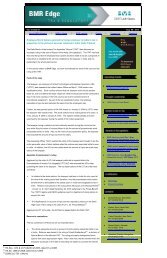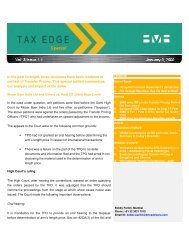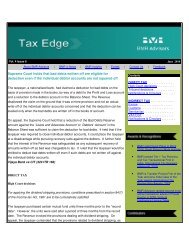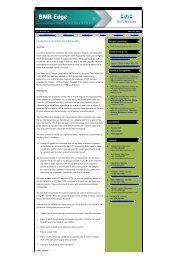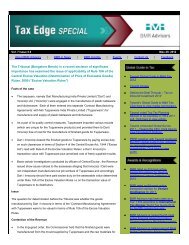Corporate Tax 2010 - BMR Advisors
Corporate Tax 2010 - BMR Advisors
Corporate Tax 2010 - BMR Advisors
You also want an ePaper? Increase the reach of your titles
YUMPU automatically turns print PDFs into web optimized ePapers that Google loves.
Yulchon, Attorneys at Law<br />
Korea<br />
foreign controlling shareholder (“FCS”) that exceed three times the<br />
equity capital attributable thereto.<br />
A foreign party can qualify as an FSC based on an equity test or a<br />
control test and the FCS can be a shareholder, direct or indirect, or<br />
a non-shareholder affiliated entity, such as a sister company.<br />
For purposes of thin-capitalisation rules, borrowings from an FCS<br />
include amounts borrowed from an unrelated third party based upon<br />
the FCS’s guarantee.<br />
3.5 If so, is there a “safe harbour” by reference to which tax<br />
relief is assured<br />
A “safe harbour” is granted under the LCITA up to the ratio of debt<br />
owned to an FCS to equity of 3:1 or less (6:1 or less for financial<br />
service industry).<br />
Further, if the conditions and the amount of debt owed to the FCS<br />
are reasonable compared to the debt from an independent third<br />
party, such debt from the FCS may be excluded from the scope of<br />
the debt subject to thin-capitalisation rules, in which case the<br />
interest thereon would be deductible.<br />
3.6 Would any such “thin capitalisation” rules extend to debt<br />
advanced by a third party but guaranteed by a parent<br />
company<br />
The Korean transfer pricing regulations also include a concept of<br />
secondary adjustments. Specifically, secondary adjustments are<br />
additional tax treatments that occur if a transfer pricing adjustment<br />
is not repatriated back to Korea. Most secondary adjustments are<br />
treated as deemed dividends subject to withholding taxes at<br />
domestic rates or any applicable tax treaty. The secondary effect<br />
can be avoided by having the foreign transactional party pay the<br />
amount of adjusted income back to the Korean party.<br />
In recent years, the Korean National <strong>Tax</strong> Service (“NTS”) has made<br />
the enforcement of transfer pricing compliance a high priority, and<br />
the transfer pricing has become a routine part of a tax audit.<br />
A recent change to Korea’s transfer pricing rules may allow relief<br />
from penalties with respect to transfer pricing adjustments for<br />
taxpayers that have maintained contemporaneous documentation of<br />
their transfer prices. The amendment applies to adjustments made<br />
to taxable income and to tax levied after the amendment’s effective<br />
date of January 1, 2009. Under the new measures, relief from the<br />
penalty with respect to a transfer pricing adjustment can be allowed<br />
if: (1) the taxpayer can show it properly prepared and maintained<br />
documentation demonstrating an arm’s length price at the time of<br />
the preparation of the tax return; and (2) the tax authorities<br />
determine that the method used was reasonable.<br />
4 <strong>Tax</strong> on Business Operations: General<br />
Korea<br />
Borrowings from a third party under a guarantee extended by an<br />
FCS are also covered by the thin-capitalisation rule. A “guarantee”<br />
includes a “guarantee in substance such as a pledge of assets” and<br />
all types of guarantee arrangements under which an FCS is required<br />
to effectively pay off a loan extended to a Korean subsidiary,<br />
regardless of the existence of any guarantee letter or the method of<br />
ay guarantee. In this respect, the Korean tax authorities held on<br />
many occasions that a comfort letter or a letter of intent issued by<br />
an FCS could fall within the scope of a “guarantee”, despite the lack<br />
of legal binding effect.<br />
3.7 Are there any restrictions on tax relief for interest<br />
payments by a local company to a non-resident in addition<br />
to any thin capitalisation rules mentioned in questions<br />
3.4-3.6 above<br />
In addition to the thin-capitalisation rules, the inter-company<br />
borrowing arrangements between a Korean company and its foreign<br />
affiliate must comply with the arm’s length principle under the<br />
Korean transfer pricing rules for the interest payments by the<br />
Korean company to be fully deductible.<br />
3.8 Does Korea have transfer pricing rules<br />
4.1 What is the headline rate of tax on corporate profits<br />
For fiscal years commencing during the period between January 1,<br />
2009 and December 31, 2009, the effective corporate tax rates are<br />
11% on income under KRW 200 million and 22% for income<br />
exceeding KRW 200 million. The rate will be further reduced in<br />
<strong>2010</strong> to 10% on the first KRW 200 million and 20% on the excess.<br />
Corporations (both domestic and foreign) are also subject to a<br />
resident surtax at the rate of 10% of the corporate income tax<br />
liability, which makes the current effective tax rate 24.2% (22%<br />
from <strong>2010</strong> onwards) for income in the higher tax bracket.<br />
4.2 When is that tax generally payable<br />
<strong>Corporate</strong> income tax returns must be filed annually within three<br />
months from the last day of each fiscal year, together with any<br />
corporate tax payment due. Also, semi-annual returns, together<br />
with the tax payment due, must be filed within two months from the<br />
end of the first six-months of the fiscal year.<br />
4.3 What is the tax base for that tax (profits pursuant to<br />
commercial accounts subject to adjustments; other tax<br />
base)<br />
A comprehensive cross-border transfer pricing regime was introduced<br />
in 1996 with the enactment of the LCITA. The LCITA stipulates that<br />
transfer prices should be consistent with arm’s length prices. The<br />
transfer pricing methods specified in the LCITA and underlying<br />
Presidential Decree are listed in the order of priority below:<br />
comparable uncontrolled price method, resale price method<br />
or cost plus method;<br />
profit split method, transactional net margin method or Berry<br />
ratio method; and<br />
other unspecified methods.<br />
Transfer prices should be supported by the most reasonable transfer<br />
pricing method while giving consideration to the order of method<br />
priority.<br />
ICLG TO: CORPORATE TAX <strong>2010</strong><br />
© Published and reproduced with kind permission by Global Legal Group Ltd, London<br />
The tax base for the corporate income tax is the income for each<br />
business year remaining after deductions of certain nontaxable<br />
items, which generally correspond to the profits pursuant to<br />
commercial accounts subject to certain adjustments as prescribed<br />
by the CITA and its enforcement decrees. Companies may carry<br />
forward losses for 10 years.<br />
4.4 If it otherwise differs from the profit shown in commercial<br />
accounts, what are the main other differences<br />
The main differences between commercial and tax accountings are<br />
the timing of income and expense recognition, and permanent<br />
differences include the treatment of non-deductible entertainment<br />
WWW.ICLG.CO.UK 147







